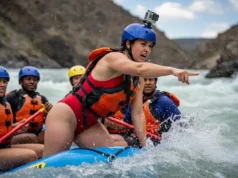In this article
The roar of the rapid is deafening, a physical force that vibrates through the floor of the raft and up into your bones. But it’s the sudden, sickening lurch sideways that steals your breath. The boat grinds against a submerged rock, and the downstream tube begins to climb skyward, reaching for the sun in a slow-motion arc of disaster. In that split second, a raft guide’s sharp, clear command—”High-Side Left!”—cuts through the chaos. On challenging rivers like California’s Tuolumne or Trinity, this isn’t just jargon; it’s a lifeline. Mastering the high-side command is a critical whitewater rafting technique that transforms you from a passenger at the mercy of the river into an active participant in your own survival, turning a potential disaster into a controlled, tactical maneuver.
In the moments that follow, we’ll dissect this critical safety maneuver, moving from the heart-pounding theory to practical, life-saving action. We will explore the high-side imperative by understanding the primary threats—wraps, pins, and flips—it is designed to prevent. We’ll delve into the raw physics of stability, discovering how your crew’s weight becomes a weapon to counteract the immense rotational force of the river. We will learn the crucial tactical difference between proactive commands like the “Overs” command and the reactive, emergency “High-Side,” and finally, see how the pre-trip safety talk and on-water drills build the instinct required for an instantaneous response when it matters most. This is where knowledge becomes competence in whitewater rafting.
The High-Side Imperative: Anatomy of a Capsize Threat
To understand the solution, you must first respect the problem. The high-side command exists because a river’s turbulent waters generate forces powerful enough to flip a multi-ton raft with terrifying ease. This section establishes the critical context for the command, defining what it is and detailing the specific, dangerous river scenarios and trigger events that make it a non-negotiable part of whitewater rafting safety.
Defining the High-Side Command: More Than Just a Lean
At its core, the high-side is a critical, last-second maneuver where the crew aggressively shifts their entire body weight to the side of the raft that is tilting up and out of the water—the “high side.” It is initiated by a clear, loud verbal command from the guide, such as “High Side!” often followed by a direction like “Right!” or “Left!” to eliminate any ambiguity in the chaotic environment of a rapid. Its primary purpose is to counteract powerful external forces from a trigger event—like a raft hitting a rock, getting caught in a hydraulic, or quickly move to the side of the raft that is being hit by a wave or is rising—that is actively destabilizing the boat.
This is not a casual lean; it is a full-body, explosive movement intended to rapidly redistribute the crew’s mass and re-stabilize the raft’s equilibrium. A successful high-side can be the definitive action that prevents a full capsize, sometimes resulting in a dramatic but controlled “tube stand,” where the raft rears up on one tube before settling back down. This command is born from a guide’s deep understanding of U.S. National Park Service river safety guidelines and their ability to anticipate threats, making it a calculated counter-maneuver. It is the physical application of reading the river’s intent, and it connects directly to the full spectrum of rafting commands used to maintain control.
The Tipping Point: Understanding Wraps, Pins, and Flips
With a clear definition of the action, the next step is to understand the terrifying scenarios it’s designed to prevent. This is where theory meets consequence. The three primary threats are wraps, pins, and flips.
A Wrap occurs when a raft strikes an obstacle, usually a large rock, broadside. This raft broaching on obstacle is a classic trigger event. The current’s immense force pushes the downstream tube up onto the rock while simultaneously pressing the upstream tube down into the water. Without an immediate and aggressive high-side, the current can completely submerge the upstream tube, creating a situation where the raft is pinned broadside on a rock and potentially folding under thousands of pounds of hydraulic pressure. A successful high-side, or “high siding,” involves moving all weight to the downstream (high) side, counteracting this force, allowing the current to flow under the raft and the upstream tube to break the surface. This is a primary way to un-pin a raft.
A Flip, or capsize, represents a total loss of control and is the most common cause of a “mass-swimmer” event. Rafts flip when their stability is overcome. This is frequently caused by entering a powerful hydraulic (“hole”) sideways, where the recirculating water, governed by the fundamental principles of fluid dynamics, grabs the upstream tube and pulls it under. They can also be caused by the raft riding up a boulder where the river’s force simply overcomes the boat’s stability, lifting one side until it capsizes. The high-side is the primary defensive command issued to prevent a flip in both of these scenarios. It’s a direct opposition to the rotational force, and understanding the tactics of navigating a powerful hydraulic is key to preventing the need for it in the first place.
The Physics of Stability: Why High-Siding Works
The high-side isn’t magic; it’s physics. This section delves into the fundamental principles of the physics of stability that explain exactly why this maneuver is so effective, moving from an abstract command to tangible science. It’s a battle of levers and forces, and your crew’s collective weight is the weapon that tips the scales in your favor.
The Center of Gravity as a Weapon: How Crew Weight Shifts the Balance
The key to understanding why high-siding works lies in the concepts of the Center of Gravity (CG) and the Center of Buoyancy (CB). The Center of Gravity is the single point where the entire mass of the raft system—boat, gear, and crew—is concentrated. The Center of Buoyancy is the geometric center of the submerged volume of the raft, the point where the upward buoyant force acts.
When a raft is level in calm water, the CG (downward force) and CB (upward force) are vertically aligned, creating a stable state. When a raft broaches, however, the current forces the upstream tube down. This changes the shape of the submerged volume, causing the CB to shift toward that now-lower, upstream side. The CG, however, remains relatively centered. This horizontal separation between the upward force of the CB and the downward force of the CG creates a powerful rotational force, or torque, that acts to violently flip the boat. These are the core principles behind demonstrations of stability in flotation.
The high-side command is a direct intervention against this flipping torque. By aggressively shifting weight, the crew moves the raft’s overall CG toward the rising high side. This action moves the downward force of gravity (CG) over the rising side of the boat, using the crew’s own weight as a lever to push that side back down, counteract the torque, and restore equilibrium.
Execution and Command: From Verbal Cue to Physical Action
Now that the scientific “why” is clear, let’s break down the precise actions that translate this physical principle into a life-saving maneuver on the water. Successful on-river execution hinges on a perfect chain of events: a clear command from the guide and an immediate, aggressive, and coordinated response from an agile and responsive crew.
The Crew’s Response: A Step-by-Step Guide to the Maneuver
When the command comes, hesitation is the primary cause of failure. The response must be an explosion of coordinated movement.
The moment the command is heard, paddlers on the upstream (“low”) side must completely leave their seated positions and dive across the raft toward the high side of the raft. Those already on the high side must throw their body weight hard onto that tube. The objective is to transfer as much mass as possible. Paddlers moving across should aim to get their chest and upper body fully onto the high-side tube, often landing in the space just in front of the person who normally sits opposite them.
Pro-Tip: Don’t just lean, climb. The goal is to get your weight as far out over the rising tube as possible. A good mental cue is to try to get your belly button over the outer seam of the high-side tube. You are actively trying to push that tube back down into the water with your body.
Throughout this aggressive lunge, safety for your fellow crew is paramount. Each paddler must maintain control of their paddle, keeping one hand firmly on the T-grip and dragging the paddle behind them to ensure the T-grip or blade doesn’t strike another person. This is where Maintaining control of your rafting paddle becomes a critical safety skill. The crew must remain in this high-side position, actively applying their weight, until the immediate danger has passed and the raft has stabilized. Only return to your paddling positions upon hearing the guide’s follow-up command, such as “Back to position!” This ensures everyone is ready to resume paddling immediately.
A responsive crew is more than just a group of individuals; they are a team. Great paddlers listen intently and anticipate the guide’s needs, understanding that paddle talk is constant communication. Paddle training and a thorough pre-trip drill are essential for building this cohesion. It ensures that when associated commands like “Get Down!” (to lower the center of gravity in big rapids) or “Hold On!” (to brace for the shock of impact) are given, the whole boat reacts as one. This level of teamwork is what turns a group of rafters into a confident paddle crew, ready for any river trip.
Tactical Command: A Guide’s Hierarchy of Stability Responses
Executing this reactive maneuver is critical, but an expert guide’s goal is to avoid needing it in the first place by using proactive commands. There is a hierarchy of stability responses, and understanding this tactical decision framework is key to advanced rafting. This is a content area that professional guide schools emphasize for certified guides.
Proactive vs. Reactive: The Critical Distinction Between “Overs” and “High-Side”
These two commands form the core of lateral stability, but the choice between high-side versus overs is worlds apart in its application and implication.
The “Overs” command (“Over Right!” or “Over Left!”) is a pre-emptive, proactive maneuver. It is called before the raft makes contact with a known or anticipated lateral threat, like a rock or a powerful wave. The intent is to pre-emptively weight the boat, ensuring the upstream tube rides high over the current and preventing it from ever being caught or submerged. The use of an “Overs” command is the mark of an experienced guide who is reading the water far ahead and strategically positioning the raft for a clean passage. It is a sign of being in control.
The “High-Side” command, in contrast, is an emergency, reactive self-rescue technique. It is called when the raft is already in the process of being tilted and is in immediate danger of capsizing. It signifies that the situation has escalated to a critical point. As one A Frostburg State University rafting course manual bluntly states, “By the time a tube is the ‘hyside’ it is too late.” On the continuous Class V rapids of a run like Cherry Creek or the Cal Salmon River, a guide’s primary goal is to use proactive commands to avoid this last-ditch scenario, because it can be called too late. While a well-executed high-side can still save the boat, the need for it indicates a loss of primary control. It’s often a direct response to avoiding common paddling mistakes.
Pro-Tip: As a guide, your primary goal for any given rapid is to never have to yell “High-Side!” An “Overs” call is a sign of successful planning and execution. A “High-Side” call is a necessary save, but it’s a save from a situation that has already become critical. Plan for the “Over,” be ready for the “High-Side.”
| Command | Timing | Threat Level | Primary Goal | Crew Action |
|---|---|---|---|---|
| Lean In | Proactive | Low/Moderate | Balance/Bracing | Lean toward center of raft |
| Get Down | Proactive | High | Maximize Stability | Move to floor of raft |
| Overs | Proactive | High/Specific | Prevention | Shift weight to one side |
| High-Side | Reactive | Critical/Imminent | Emergency Save | Dive to the high side |
Conclusion
The “High-Side” is a reactive, emergency command where the crew shifts weight to the rising tube of the raft to prevent a flip, wrap, or pin. It works by repositioning the raft’s Center of Gravity to directly counteract the rotational torque being applied by the river’s hydraulic forces. It is tactically distinct from the proactive “Overs” command, which is used before encountering a threat to pre-emptively stabilize the raft. Ultimately, the effectiveness of the high-side command is entirely dependent on a robust training protocol and safe boating practices, moving from cognitive understanding in a briefing to ingrained muscle memory through on-water drills.
The high-side is a critical tool in your safety toolkit, but it’s just one piece of the puzzle. Explore our comprehensive guides on river safety and rescue techniques to build the confidence and skill needed to navigate any rapid.
Frequently Asked Questions about the High-Side Command
What is the difference between a “High-Side” and an “Over” command?
An “Over” command is proactive, called before hitting an obstacle to pre-weight the correct side. A “High-Side” is reactive, called during a capsize event as an emergency fix. Think of “Overs” as good planning and “High-Side” as damage control.
What happens if you lean the wrong way or to the “low side”?
Leaning to the “low side” (the side being pushed down by the water) is the worst possible action and will accelerate the capsize. This adds your weight to the force of the river, guaranteeing a flip.
Is a high-side only for rafts hitting rocks?
No, the high-side is used to counteract any significant lateral force that threatens to flip the raft. This includes being hit by a large lateral wave or getting stuck sideways in a powerful hydraulic (a “hole”).
How do you know which side is the “high side”?
The “high side” is simply the side of the raft that is physically higher in the air or tilting up out of the water. Guides will almost always specify a direction, such as “High-Side Right!”, to remove any doubt during the critical moment.
Risk Disclaimer: Whitewater rafting, kayaking, and all related river sports are inherently dangerous activities that can result in serious injury, drowning, or death. The information provided on Rafting Escapes is for educational and informational purposes only. While we strive for accuracy, the information, techniques, and safety advice presented on this website are not a substitute for professional guide services, hands-on swiftwater rescue training, or your own critical judgment. River conditions, including water levels, currents, and hazards like strainers or undercut rocks, change constantly and can differ dramatically from what is described on this site. Never attempt to navigate a river beyond your certified skill level and always wear appropriate safety gear, including a personal flotation device (PFD) and helmet. We strongly advise rafting with a licensed professional guide. By using this website, you agree that you are solely responsible for your own safety. Any reliance you place on our content is strictly at your own risk, and you assume all liability for your actions and decisions on the water. Rafting Escapes and its authors will not be held liable for any injury, damage, or loss sustained in connection with the use of the information herein.
Affiliate Disclosure: We are a participant in the Amazon Services LLC Associates Program, an affiliate advertising program designed to provide a means for us to earn advertising fees by advertising and linking to Amazon.com. As an Amazon Associate, we earn from qualifying purchases. We also participate in other affiliate programs and may receive a commission on products purchased through our links, at no extra cost to you. Additional terms are found in the terms of service.





